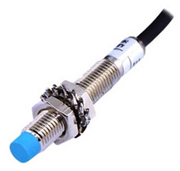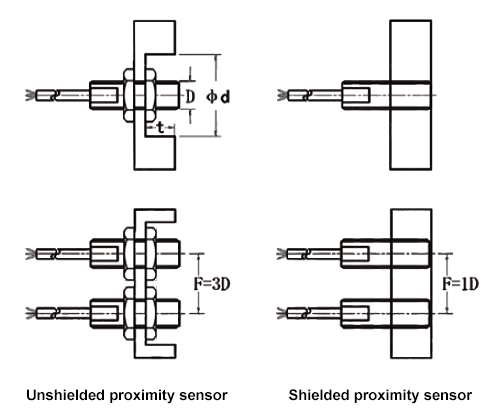Proximity Sensor Selection Guide
Proximity sensor belongs to the non-contact static position switch. When an object approaches it at a certain distance, the proximity switch gives an action signal. Different from the mechanical position switch that needs to be applied with mechanical force, the proximity switch acquires signal by the change of medium energy between the probe and the object under test. The proximity switch is widely used and has exceeded its scope of limit and protection, and common applications include speed measurement, liquid level control, and metal detection. When you are going to buy a proximity sensor but without any suggestion of others, you will be clear after reading this article.
Firstly, before choosing a proximity sensor, we have to know some important things about it.
1. Types of the proximity sensor
According to the working principles, the proximity sensor can be divided into inductive proximity sensor, capacitive proximity sensor and magnetic inductive proximity sensor. It can also be divided into AC proximity sensor and DC proximity sensor according to the current type of the circuit applied.
- Inductive proximity sensor: Its sensor head is an inductive coil with a ferrite core, so it can only be used to detect metals. It's widely used in industries.
- Capacitive proximity sensor: Its sensor head is a circular plate electrode, while another polar plate is the object itself. When the object moves towards the proximity sensor, the dielectric constant of the object and the proximity sensor changes, thus generating signal output. The capacitive proximity sensor can not only detect metals but also detect nonmetallic objects or liquids.
- Magnetic induction proximity sensor: It mainly refers to the Hall proximity sensor. Its working principle is mainly based on the Hall effect, namely, signal outputs when the magnetic objects approach the Hall switch. And it's mainly used to judge whether the cylinder is pushed or retracted to the specific position.
- Special proximity sensors: When detecting in some narrow space or harsh working environments, such as high temperature, humidity, large disturbance or explosive environment with a high precision requirement, we need to use the fiber optic proximity sensor or pneumatic proximity sensor. However, these sensors are relatively expensive.
2. Advantages of Proximity Sensor
- The proximity sensor belongs to non-contact measurement, so it wouldn't wear or damage the detection objects.
- As the proximity sensor adopts non-contact output, its service life can be extended. The NPN/PNP output it adopts has no effect on the service life of contacts.
- The proximity sensor is not affected by the stains, oil and water on the detection objects.
- High-speed response of the proximity switch can be 3 kHz.
3. Disadvantages of Proximity Sensor
- Detection distance of the proximity switch is significantly different according to the material of detection objects. Generally, the detection distance will be smaller when the detection object is a nonmagnetic metal (such as aluminum).
- Proximity switches would interfere with each other due to the influence of magnetic (or electrostatic capacities) of adjacent sensors, so its output is unstable.
- When the proximity switch turns off, there are a few leakages of current due to the operation of the circuit. As a result, a few amounts of current would be maintained in the load (residual voltage of load), and the load can't be well reset.
Secondly, how to select a proximity sensor?
Step 1: Detection object
When detecting metals, the inductive proximity sensor should be selected in priority. when detecting nonmetallic materials, the capacitive proximity sensor should be selected in priority. When detecting magnetic signals, the magnetic induction proximity sensor should be selected in priority.
Step 2: Dimension
The dimension shall be selected according to the actual application occasions and situations, commonly used dimension of proximity sensor is the cylindrical thread shape like M8 series.
Step 3: Detection range
Selection of detection range shall be determined by needs, but it shall be noted that the detection distance of the same proximity sensor is not constant, it's related with the material, size and movement direction of the objects under test.
Step 4: Shielded or unshielded
- Unshielded proximity sensor can achieve the biggest action distance (related to the diameter). In order to avoid the influence from the metal surrounding the proximity sensor, unshielded proximity sensor head must keep a certain space with the surrounding metal.
- Shielded proximity sensor can be flush mounted inside the metal, because of the inside special shielding effect, the magnetic field of side radial decrease and the sensing distance is about 60% of unshielded type.

Step 5: Output signal
- Whether the AC signal or DC signal is output, the AC proximity sensor outputs AC signal and DC proximity sensor outputs DC signal.
- DC output signal can be further divided into NPN output and PNP output.
- Moreover, the load current shall be smaller than the output current of the proximity sensor.
Step 6: Number of contact
The proximity sensor has NO contact, NC contact, and NO+NO contacts. It can be selected according to specific circumstances.
Step 7: Switching frequency
Switching frequency determines the response speed of the proximity switch, it refers to the shifting number of the switch from on to off per minute. The switching frequency of DC proximity sensor can be 200kHz, while the switching frequency of AC proximity sensor is much smaller, which is 25Hz.
Step 8: Supply voltage of the proximity sensor
- For AC proximity sensors, voltages of AC110V, AC220V or AC36V should be selected in priority.
- For DC proximity sensors, voltages of DC12V or DC24 should be selected in priority.

